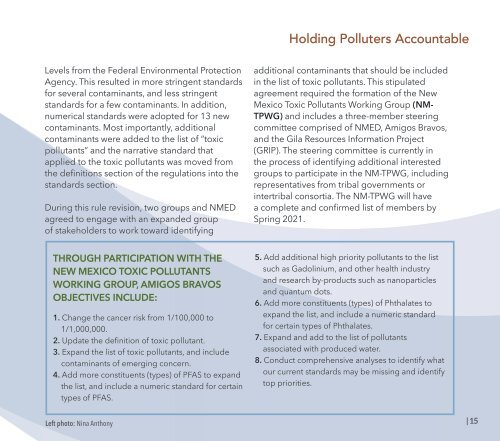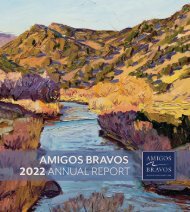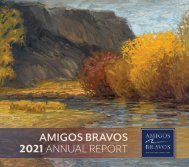Create successful ePaper yourself
Turn your PDF publications into a flip-book with our unique Google optimized e-Paper software.
Holding Polluters Accountable<br />
Levels from the Federal Environmental Protection<br />
Agency. This resulted in more stringent standards<br />
for several contaminants, and less stringent<br />
standards for a few contaminants. In addition,<br />
numerical standards were adopted for 13 new<br />
contaminants. Most importantly, additional<br />
contaminants were added to the list of “toxic<br />
pollutants” and the narrative standard that<br />
applied to the toxic pollutants was moved from<br />
the definitions section of the regulations into the<br />
standards section.<br />
During this rule revision, two groups and NMED<br />
agreed to engage with an expanded group<br />
of stakeholders to work toward identifying<br />
additional contaminants that should be included<br />
in the list of toxic pollutants. This stipulated<br />
agreement required the formation of the New<br />
Mexico Toxic Pollutants Working Group (NM-<br />
TPWG) and includes a three-member steering<br />
committee comprised of NMED, <strong>Amigos</strong> <strong>Bravos</strong>,<br />
and the Gila Resources Information Project<br />
(GRIP). The steering committee is currently in<br />
the process of identifying additional interested<br />
groups to participate in the NM-TPWG, including<br />
representatives from tribal governments or<br />
intertribal consortia. The NM-TPWG will have<br />
a complete and confirmed list of members by<br />
Spring 2021.<br />
THROUGH PARTICIPATION WITH THE<br />
NEW MEXICO TOXIC POLLUTANTS<br />
WORKING GROUP, AMIGOS BRAVOS<br />
OBJECTIVES INCLUDE:<br />
1. Change the cancer risk from 1/100,000 to<br />
1/1,000,000.<br />
2. Update the definition of toxic pollutant.<br />
3. Expand the list of toxic pollutants, and include<br />
contaminants of emerging concern.<br />
4. Add more constituents (types) of PFAS to expand<br />
the list, and include a numeric standard for certain<br />
types of PFAS.<br />
5. Add additional high priority pollutants to the list<br />
such as Gadolinium, and other health industry<br />
and research by-products such as nanoparticles<br />
and quantum dots.<br />
6. Add more constituents (types) of Phthalates to<br />
expand the list, and include a numeric standard<br />
for certain types of Phthalates.<br />
7. Expand and add to the list of pollutants<br />
associated with produced water.<br />
8. Conduct comprehensive analyses to identify what<br />
our current standards may be missing and identify<br />
top priorities.<br />
Left photo: Nina Anthony<br />
| 15







